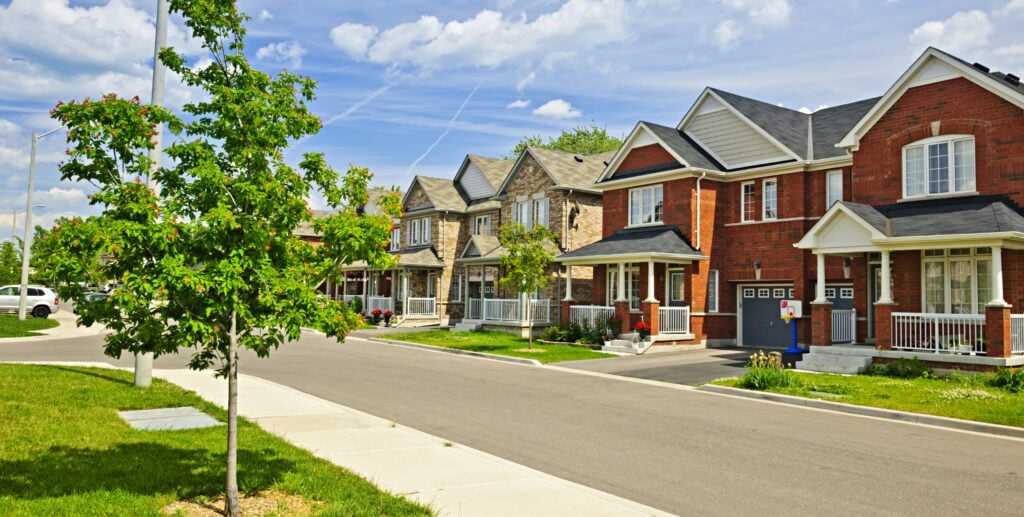A groundbreaking plan could transform fragmented blocks like this into vibrant, high-quality social housing precincts across Victoria. Picture: Anna O’Gorman Architects / Christopher Frederick Jones
A bold plan to turn suburban community housing hubs into supersized developments could add 26,000 new homes for at- risk Victorians within a decade.
The move could also slash the cost of social housing borne by taxpayers $2bn.
An exclusive report by Swinburne University and Ys Housing, backed by the Community Housing Industry Association Victoria and 10 community housing providers, reveals how amalgamating fragmented housing sites could supercharge the supply of affordable homes across Melbourne, Geelong, Ballarat and Bendigo.
The strategy would allow not-for-profit housing organisations to purchase neighbouring lots next to their existing homes, merging them to build larger, modern social housing projects at scale, without relying on private developers.
RELATED: Iconic Melb pool site could fetch $3m
Experts warn: Buyers about to strike
How this basic Melb unit blitzed auction
The discussion paper suggests the strategy could be expanded beyond the initial 26,000 homes, eventually delivering up to 65,000 new social dwellings with further funding, enough to wipe out Victoria’s current social housing waitlist.
The report identifies 1637 sites that could be consolidated over a decade, cutting project costs by up to $250,000 per dwelling thanks to cheaper land and more efficient construction.
CHIA Victoria chief executive Sarah Toohey says Victoria has a “golden but narrow” window to unlock thousands of genuinely affordable homes.
Striking low-rise designs show how community housing can be both affordable. Picture: Anna O’Gorman Architects / Christopher Frederick Jones
CHIA Victoria chief executive Sarah Toohey said the government had a “golden but narrow window of opportunity” before rising land prices made these sites unaffordable.
“If we don’t act quickly, it will mean fewer affordable homes for Victorians and a more expensive social housing budget in the long run,” Ms Toohey said.
“This is a chance for not-for-profits to build homes that are genuinely affordable, not hand prime land to private developers chasing profit.”
The model would cost the state an estimated $80m per year over 10 years, with long-term public savings forecast at $1.99bn.
Ys Housing CEO Oscar McLennan says site amalgamation offers a voluntary, future-proofed solution to Victoria’s housing crunch.
Smart, flexible floorplans like this one are key to reimagining how social housing is delivered in established suburbs. Picture: Anna O’Gorman Architects / Christopher Frederick Jones
Ys Housing chief executive Oscar McLennan said the plan would apply only where neighbouring homeowners volunteered to sell their properties.
“Site amalgamation is a strategic and sustainable way to help safeguard Victoria’s social housing future,” Mr McLennan said.
Monash University urban planning expert Dr Elizabeth Taylor has researched lot consolidation extensively and said it was a proven approach overseas that could deliver vastly improved housing outcomes, if supported by planning reform and long-term funding.
“It opens the door to better housing typologies, more green space and co-ordinated masterplans, instead of the site-by-site scramble we currently see.,” Dr Taylor said.
Monash University Urban planning expert Dr Elizabeth Taylor says lot consolidation unlocks greener, better-designed communities, if backed by planning reform.
Victoria’s planning system were still too focused on individual sites, particularly in Neighbourhood Residential and General Residential Zones, which account for most of the flagged locations, Dr Taylor said.
“Most of these sites are not in activity centres where fast-tracking happens,” she said.
“Planning settings like zoning and carparking requirements make it hard to deliver the well-designed, ‘missing middle’ housing we actually need.”
The proposal also highlights the challenges faced by community housing organisations, which, despite holding long-term land, often struggle to access finance for precinct-scale projects.
Thoughtfully designed interiors, like this modern kitchen, show what’s possible when not-for-profits lead housing delivery. Picture: Anna O’Gorman Architects / Christopher Frederick Jones
“CHOs are probably better placed than most to do this, but they face bigger financial constraints than private developers,” Dr Taylor said.
“Our current funding models are too short-term and fragmented. This approach needs real support to succeed.”
The new model aims to correct the system’s current bias toward cheap infill townhouses and speculative high-rise towers, shifting focus to quality, longevity and liveability.
While the plan’s backers emphasise it won’t involve forced relocation, some tenant groups remain sceptical.
RAHU secretary Harry Millward warns the buy-up model risks quiet displacement under the guise of gentle density.
Renters and Housing Union (RAHU) secretary Harry Millward said any voluntary buy-up of neighbouring sites risked pushing low-income families out of the area.
“This is gentrification dressed up as gentle density,” Mr Millward said.
“Community housing groups act like landlords, and this could quietly displace people who’ve called these neighbourhoods home for decades.”
But Ms Toohey argued the plan would increase access to affordable housing where the private market had failed.
These community homes showcase how well-integrated, human-scale architecture could blend into existing neighbourhoods. Picture: Anna O’Gorman Architects / Christopher Frederick Jones
“Critics claiming to speak for renters have it wrong,” Ms Toohey said.
“Amalgamating sites for community housing could deliver tens of thousands of additional genuinely affordable homes, something the private rental market is failing to do.
“The properties next door to community housing may not even be rentals, let alone be affordable for low-income families who are increasingly priced out of the private housing market.”
Lush landscaping, natural light and simple lines define this next-gen social housing model. Picture: Anna O’Gorman Architects / Christopher Frederick Jones
The private rental market is failing, and expanding social housing through site amalgamation is an innovative solution.”
The proposal comes as CHIA Australia and PowerHousing Australia merge this week to create Australian Community Housing, a new national peak body representing over 160 community housing providers and 134,000 homes.
ACH chair Rebecca Oelkers said the newly unified group would speak with “one voice” to help accelerate affordable housing delivery at scale.
Sign up to the Herald Sun Weekly Real Estate Update. Click here to get the latest Victorian property market news delivered direct to your inbox.
MORE: James Packer’s new deal at Melbourne supermarket site
Inside ‘Hospitality Yoda’s luxe Melb home
Tragic side of Aus housing crisis exposed
david.bonaddio@news.com.au



















 English (US) ·
English (US) ·